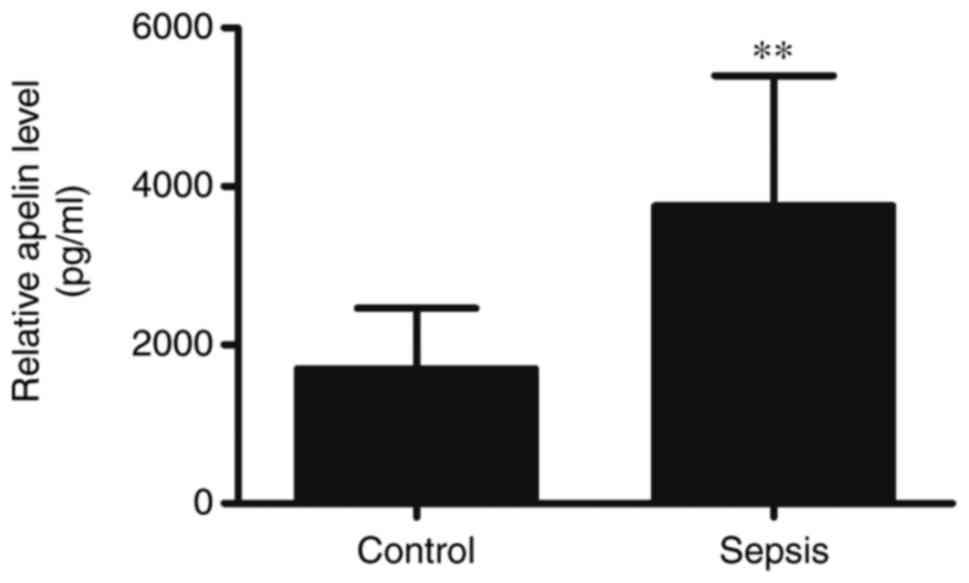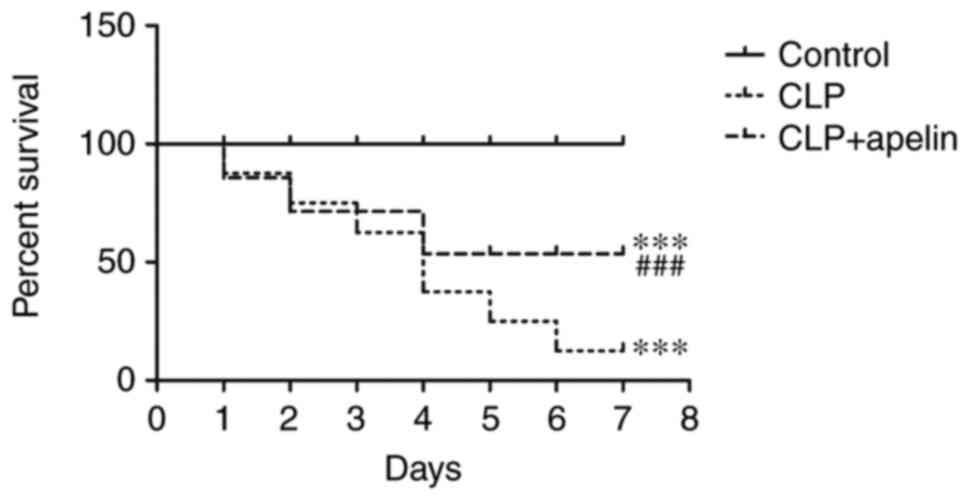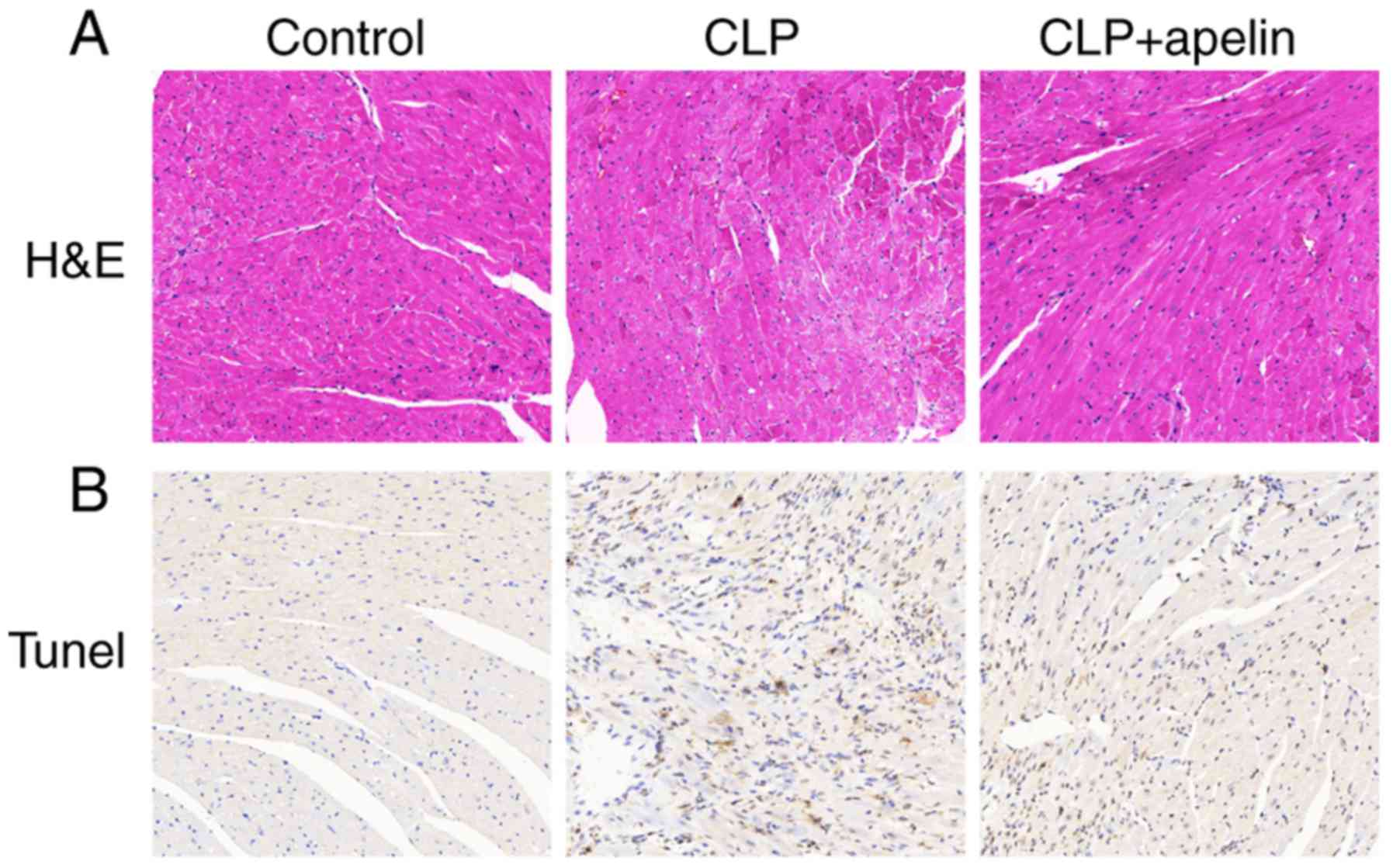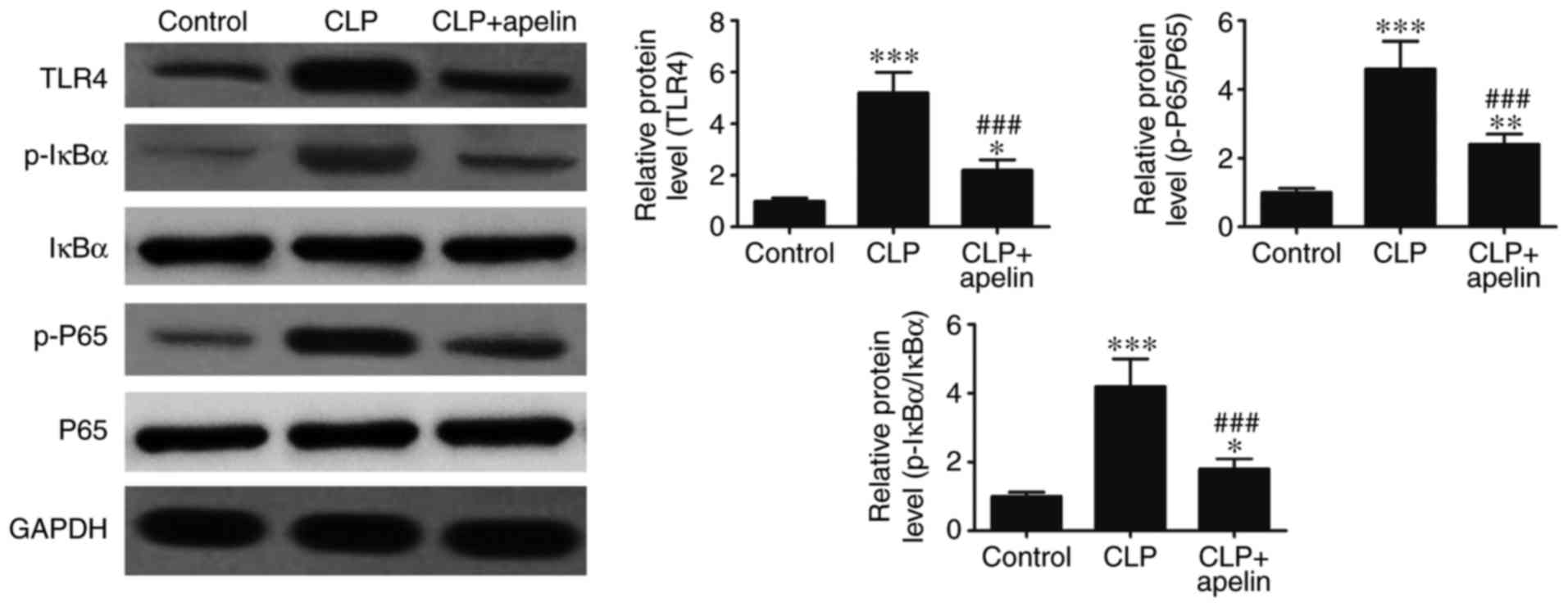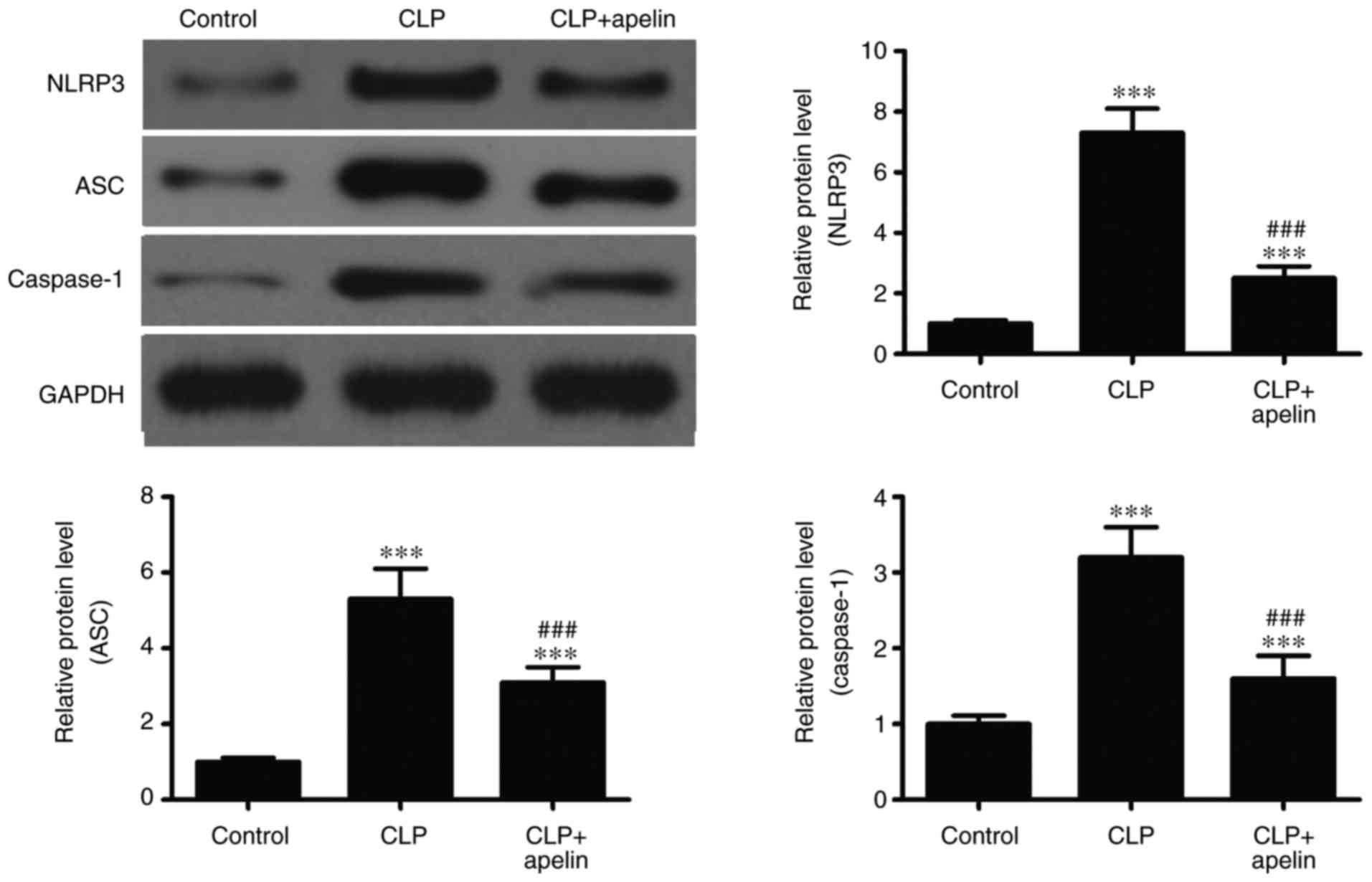|
1
|
Papadopoulos P, Pistiki A,
Theodorakopoulou M, Christodoulopoulou T, Damoraki G, Goukos D,
Briassouli E, Dimopoulou I, Armaganidis A, Nanas S, et al:
Immunoparalysis: Clinical and immunological associations in SIRS
and severe sepsis patients. Cytokine. 92:83–92. 2017. View Article : Google Scholar : PubMed/NCBI
|
|
2
|
Alam N, de Ven PM, Oskam E, Stassen P,
Kramer MH, Exter PV and Nanayakkara PW: Study protocol for a
multi-centre, investigator-initiated, randomized controlled trial
to compare the effects of prehospital antibiotic treatment for
sepsis patients with usual care after training emergency medical
services (EMS) personnel in early recognition (- The prehospital
antibiotics against sepsis (PHANTASi) trial. Acute Med. 15:176–184.
2016.
|
|
3
|
Li L, Hu BC, Chen CQ, Gong SJ, Yu YH, Dai
HW and Yan J: Role of mitochondrial damage during cardiac apoptosis
in septic rats. Chin Med J. 126:1860–1866. 2013.PubMed/NCBI
|
|
4
|
Ndongson-Dongmo B, Heller R, Hoyer D,
Brodhun M, Bauer M, Winning J, Hirsch E, Wetzker R, Schlattmann P
and Bauer R: Phosphoinositide 3-kinase gamma controls
inflammation-induced myocardial depression via sequential cAMP and
iNOS signalling. Cardiovasc Res. 108:243–253. 2015. View Article : Google Scholar : PubMed/NCBI
|
|
5
|
Kalbitz M, Fattahi F, Grailer JJ, Jajou L,
Malan EA, Zetoune FS, Huber-Lang M, Russell MW and Ward PA:
Complement-induced activation of the cardiac NLRP3 inflammasome in
sepsis. FASEB J. 30:3997–4006. 2016. View Article : Google Scholar : PubMed/NCBI
|
|
6
|
Kakihana Y, Ito T, Nakahara M, Yamaguchi K
and Yasuda T: Sepsis-induced myocardial dysfunction:
Pathophysiology and management. J Intensive Care. 4:222016.
View Article : Google Scholar : PubMed/NCBI
|
|
7
|
Sato R and Nasu M: A review of
sepsis-induced cardiomyopathy. J Intensive Care. 3:482015.
View Article : Google Scholar : PubMed/NCBI
|
|
8
|
Hinkelbein J, Kalenka A, Schubert C,
Peterka A and Feldmann RE Jr: Proteome and metabolome alterations
in heart and liver indicate compromised energy production during
sepsis. Protein Pept Lett. 17:18–31. 2010. View Article : Google Scholar : PubMed/NCBI
|
|
9
|
Zheng G, Pan M, Jin W, Jin G and Huang Y:
MicroRNA-135a is up-regulated and aggravates myocardial depression
in sepsis via regulating p38 MAPK/NF-κB pathway. Int
Immunopharmacol. 45:6–12. 2017. View Article : Google Scholar : PubMed/NCBI
|
|
10
|
Turillazzi E, Fineschi V, Palmiere C and
Sergi C: Cardiovascular involvement in sepsis. Mediators Inflamm.
2016:85847932016. View Article : Google Scholar : PubMed/NCBI
|
|
11
|
Song E, Jahng JW, Chong LP, Sung HK, Han
M, Luo C, Wu D, Boo S, Hinz B, Cooper MA, et al: Lipocalin-2
induces NLRP3 inflammasome activation via HMGB1 induced TLR4
signaling in heart tissue of mice under pressure overload
challenge. Am J Transl Res. 9:2723–2735. 2017.PubMed/NCBI
|
|
12
|
Zhang X, Du Q, Yang Y, Wang J, Dou S, Liu
C and Duan J: The protective effect of Luteolin on myocardial
ischemia/reperfusion (I/R) injury through TLR4/NF-κB/NLRP3
inflammasome pathway. Biomed Pharmacother. 91:1042–1052. 2017.
View Article : Google Scholar : PubMed/NCBI
|
|
13
|
Hao H, Cao L, Jiang C, Che Y, Zhang S,
Takahashi S, Wang G and Gonzalez FJ: Farnesoid X receptor
regulation of the NLRP3 inflammasome underlies
cholestasis-associated sepsis. Cell Metab. 25:856–867. e8552017.
View Article : Google Scholar : PubMed/NCBI
|
|
14
|
Zhang W, Tao A, Lan T, Cepinskas G, Kao R,
Martin CM and Rui T: Carbon monoxide releasing molecule-3 improves
myocardial function in mice with sepsis by inhibiting NLRP3
inflammasome activation in cardiac fibroblasts. Basic Res Cardiol.
112:162017. View Article : Google Scholar : PubMed/NCBI
|
|
15
|
Jin L, Batra S and Jeyaseelan S: Deletion
of Nlrp3 augments survival during polymicrobial sepsis by
decreasing autophagy and enhancing phagocytosis. J Immunol.
198:1253–1262. 2017. View Article : Google Scholar
|
|
16
|
Kim MJ, Yoon JH and Ryu JH: Mitophagy: A
balance regulator of NLRP3 inflammasome activation. BMB Rep.
49:529–535. 2016. View Article : Google Scholar : PubMed/NCBI
|
|
17
|
Shao QH, Zhang XL, Yang PF, Yuan YH and
Chen NH: Amyloidogenic proteins associated with neurodegenerative
diseases activate the NLRP3 inflammasome. Int Immunopharmacol.
49:155–160. 2017. View Article : Google Scholar : PubMed/NCBI
|
|
18
|
Awad F, Assrawi E, Jumeau C,
Georgin-Lavialle S, Cobret L, Duquesnoy P, Piterboth W, Thomas L,
Stankovic-Stojanovic K, Louvrier C, et al: Impact of human monocyte
and macrophage polarization on NLR expression and NLRP3
inflammasome activation. PLoS One. 12:e01753362017. View Article : Google Scholar : PubMed/NCBI
|
|
19
|
Han S, Englander EW, Gomez GA and Greeley
GH Jr: Apelin regulates nuclear factor-κB's involvement in the
inflammatory response of pancreatitis. Pancreas. 46:64–70. 2017.
View Article : Google Scholar
|
|
20
|
Luo K, Long H, Xu B and Luo Y: Apelin
attenuates postburn sepsis via a phosphatidylinositol
3-kinase/protein kinase B dependent mechanism: A randomized animal
study. Int J Surg. 21:22–27. 2015. View Article : Google Scholar : PubMed/NCBI
|
|
21
|
Zhang P, Yi LH, Meng GY, Zhang HY, Sun HH
and Cui LQ: Apelin-13 attenuates cisplatin-induced cardiotoxicity
through inhibition of ROS-mediated DNA damage and regulation of
MAPKs and AKT pathways. Free Radic Res. 51:449–459. 2017.
View Article : Google Scholar : PubMed/NCBI
|
|
22
|
Zhang X, Hu W, Feng F, Xu J and Wu F:
Apelin-13 protects against myocardial infarction-induced myocardial
fibrosis. Mol Med Rep. 13:5262–5268. 2016. View Article : Google Scholar : PubMed/NCBI
|
|
23
|
Zhou Q, Pan X, Wang L, Wang X and Xiong D:
The protective role of neuregulin-1: A potential therapy for
sepsis-induced cardiomyopathy. Eur J Pharmacol. 788:234–240. 2016.
View Article : Google Scholar : PubMed/NCBI
|
|
24
|
Xiao M, Li L, Li C, Zhang P, Hu Q, Ma L
and Zhang H: Role of autophagy and apoptosis in wound tissue of
deep second-degree burn in rats. Acad Emerg Med. 21:383–391. 2014.
View Article : Google Scholar : PubMed/NCBI
|
|
25
|
Yao L, Liu Z, Zhu J, Li B, Chai C and Tian
Y: Clinical evaluation of circulating microRNA-25 level change in
sepsis and its potential relationship with oxidative stress. Int J
Clin Exp Pathol. 8:7675–7684. 2015.PubMed/NCBI
|
|
26
|
Zhang M, Wang X, Bai B, Zhang R, Li Y and
Wang Y: Oxymatrine protects against sepsis-induced myocardial
injury via inhibition of the TNF-α/p38-MAPK/caspase-3 signaling
pathway. Mol Med Rep. 14:551–559. 2016. View Article : Google Scholar : PubMed/NCBI
|
|
27
|
An R, Zhao L, Xi C, Li H, Shen G, Liu H,
Zhang S and Sun L: Melatonin attenuates sepsis-induced cardiac
dysfunction via a PI3K/Akt-dependent mechanism. Basic Res Cardiol.
111:82016. View Article : Google Scholar
|
|
28
|
Zhao H, Zhang M, Zhou F, Cao W, Bi L, Xie
Y, Yang Q and Wang S: Cinnamaldehyde ameliorates LPS-induced
cardiac dysfunction via TLR4-NOX4 pathway: The regulation of
autophagy and ROS production. J Mol Cell Cardiol. 101:11–24. 2016.
View Article : Google Scholar : PubMed/NCBI
|
|
29
|
Lee S, Nakahira K, Dalli J, Siempos II,
Norris PC, Colas RA, Moon JS, Shinohara M, Hisata S, Howrylak JA,
et al: NLRP3 inflammasome deficiency protects against microbial
sepsis via increased lipoxin B4 synthesis. Am J Respir
Crit Care Med. 196:713–726. 2017. View Article : Google Scholar : PubMed/NCBI
|
|
30
|
Cho W, Koo JY, Park Y, Oh K, Lee S, Song
JS, Bae MA, Lim D, Lee DS and Park SB: Treatment of sepsis
pathogenesis with high mobility group box protein 1-regulating
anti-inflammatory agents. J Med Chem. 60:170–179. 2017. View Article : Google Scholar
|
|
31
|
Gao M, Ha T, Zhang X, Liu L, Wang X,
Kelley J, Singh K, Kao R, Gao X, Williams D and Li C: Toll-like
receptor 3 plays a central role in cardiac dysfunction during
polymicrobial sepsis. Crit Care Med. 40:2390–2399. 2012. View Article : Google Scholar : PubMed/NCBI
|
|
32
|
Ha T, Xia Y, Liu X, Lu C, Liu L, Kelley J,
Kalbfleisch J, Kao RL, Williams DL and Li C: Glucan phosphate
attenuates myocardial HMGB1 translocation in severe sepsis through
inhibiting NF-κB activation. Am J Physiol Heart Circ Physiol.
301:H848–H855. 2011. View Article : Google Scholar : PubMed/NCBI
|
|
33
|
Ma H, Wang X, Ha T, Gao M, Liu L, Wang R,
Yu K, Kalbfleisch JH, Kao RL, Williams DL and Li C: MicroRNA-125b
prevents cardiac dysfunction in polymicrobial sepsis by targeting
TRAF6-mediated nuclear factor κB activation and p53-mediated
apoptotic signaling. J Infect Dis. 214:1773–1783. 2016. View Article : Google Scholar : PubMed/NCBI
|
|
34
|
Gao F, Yang YZ, Feng XY, Fan TT, Jiang L,
Guo R and Liu Q: Interleukin-27 is elevated in sepsis-induced
myocardial dysfunction and mediates inflammation. Cytokine.
88:1–11. 2016. View Article : Google Scholar : PubMed/NCBI
|
|
35
|
Vaez H, Rameshrad M, Najafi M, Barar J,
Barzegari A and Garjani A: Cardioprotective effect of metformin in
lipopoly-saccharide-induced sepsis via suppression of toll-like
receptor 4 (TLR4) in heart. Eur J Pharmacol. 772:115–123. 2016.
View Article : Google Scholar
|
|
36
|
Rameshrad M, Maleki-Dizaji N, Vaez H,
Soraya H, Nakhlband A and Garjani A: Lipopolysaccharide induced
activation of toll like receptor 4 in isolated rat heart suggests a
local immune response in myocardium. Iran J Immunol. 12:104–116.
2015.PubMed/NCBI
|
|
37
|
Afonina IS, Zhong Z, Karin M and Beyaert
R: Limiting inflammation-the negative regulation of NF-κB and the
NLRP3 inflammasome. Nat Immunol. 18:861–869. 2017. View Article : Google Scholar : PubMed/NCBI
|
|
38
|
Wang N, Mao L, Yang L, Zou J, Liu K, Liu
M, Zhang H, Xiao X and Wang K: Resveratrol protects against early
polymicrobial sepsis-induced acute kidney injury through inhibiting
endoplasmic reticulum stress-activated NF-κB pathway. Oncotarget.
8:36449–36461. 2017.PubMed/NCBI
|
|
39
|
Chen J, Kieswich JE, Chiazza F, Moyes AJ,
Gobbetti T, Purvis GS, Salvatori DC, Patel NS, Perretti M, Hobbs
AJ, et al: IκB kinase inhibitor attenuates sepsis-induced cardiac
dysfunction in CKD. J Am Soc Nephrol. 28:94–105. 2017. View Article : Google Scholar
|
|
40
|
Tschopp J and Schroder K: NLRP3
inflammasome activation: The convergence of multiple signalling
pathways on ROS production? Nat Rev Immunol. 10:210–215. 2010.
View Article : Google Scholar : PubMed/NCBI
|
|
41
|
Li R, Lu K, Wang Y, Chen M, Zhang F, Shen
H, Yao D, Gong K and Zhang Z: Triptolide attenuates pressure
overload-induced myocardial remodeling in mice via the inhibition
of NLRP3 inflammasome expression. Biochem Biophys Res Commun.
485:69–75. 2017. View Article : Google Scholar : PubMed/NCBI
|



